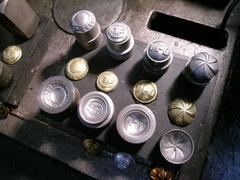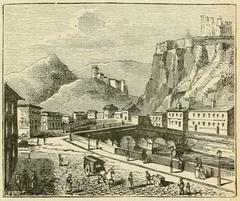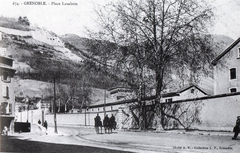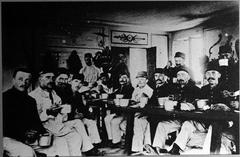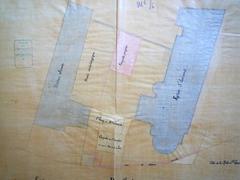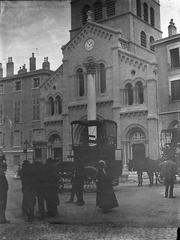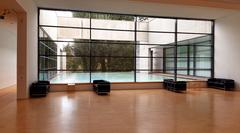
Couvent Sainte-Cécile de Grenoble: Visiting Hours, Tickets, and Comprehensive Guide
Date: 04/07/2025
Introduction
The Couvent Sainte-Cécile de Grenoble stands as a testament to the city’s layered history—a 17th-century convent transformed into a vibrant cultural and artistic venue. Located in central Grenoble, this remarkable site weaves together religious heritage, architectural splendor, and contemporary creativity. Whether you are a history buff, art enthusiast, or curious traveler, this guide provides essential insights into the Couvent’s history, visiting hours, ticketing, tours, accessibility, and practical travel tips. For the most up-to-date details, consult the official Couvent Sainte-Cécile website and the Grenoble tourism portal.
Table of Contents
- Introduction
- Historical Overview
- Visitor Information
- Architectural and Artistic Features
- Frequently Asked Questions (FAQ)
- Conclusion
- References
Historical Overview
Foundation and Early Religious Life (1624–1791)
Founded in 1624 and named after Saint Cecilia, the Couvent Sainte-Cécile initially served as a convent for the Bernardines of the Divine Providence, a contemplative branch of the Cistercian order. Its harmonious architecture—featuring a chapel, cloister, refectory, and gardens—was designed to nurture spiritual life and community worship, making it a cornerstone of 17th-century Grenoble’s religious landscape.
Revolutionary Upheaval and Military Occupation (1791–1925)
The French Revolution brought dramatic change, leading to the expulsion of the Bernardines in 1791. For over a century, the convent was repurposed for military use, altering its original features and impacting its architectural heritage.
Cultural Transformation: Cinema, Dance Hall, and Theater (1925–2004)
Beginning in 1925, the Couvent’s chapel became Le Rio cinema, later evolving into the dance bar L’Enfer and finally the Théâtre du Rio, a dynamic cultural venue under directors Georges Lavaudant and Yvon Chaix. This period marked the convent’s integration into Grenoble’s modern cultural scene.
Acquisition and Restoration by Éditions Glénat (2004–2009)
In 2004, Éditions Glénat acquired the site, launching a comprehensive restoration that preserved historic elements such as the façade, cloister, and grand staircase, while introducing contemporary features like stained-glass windows by Joost Swarte. The convent reopened to the public in 2009, coinciding with the European Heritage Days.
Contemporary Role: Cultural and Artistic Hub (2009–Present)
Today, the Couvent Sainte-Cécile is the headquarters of Éditions Glénat and the Glénat Fund for Heritage and Creation. Its spaces host exhibitions, concerts, educational programs, and the renowned Cabinet Rembrandt museum, showcasing the world’s only collection dedicated solely to Rembrandt’s engravings. The site also features a 12-meter-high library with every Glénat publication since 1969, alongside a curated bookshop.
Visitor Information
Opening Hours
- Monday to Saturday: 10:00–12:30 and 14:00–17:30
- Closed: Sundays and public holidays
Always check for exceptional closures on the official website.
Tickets and Admission
- Chapel: Free entry
- Cabinet Rembrandt & Temporary Exhibitions:
- Full Price: €7
- Reduced: €6
- Youth/Students (12–18): €5
- Children under 12: Free
- Tickets are available on-site and via the official website.
Guided Tours
- Standard and Group Tours: Available by reservation through the Grenoble Alpes Tourist Office. Group tours (from 1 person) start at €135 per guide and last 1–1.5 hours, offered in French, English, and German.
- Children’s Tours: Playful explorations tailored for young visitors, featuring comic book characters and interactive discovery (Grenoble Tourisme – Children’s Tour).
Accessibility
- The main entrance and public areas are accessible to those with reduced mobility. Some historic sections may be challenging—contact staff in advance for assistance.
- Nearby tram stops: Hubert Dubedout–Maison du Tourisme (Tram A), Sainte-Claire-les-Halles (Tram B), Hôtel de Ville (Tram C).
Facilities
- Restrooms: Available on-site
- Bookshop: Specializing in Éditions Glénat publications and gifts
- Wi-Fi: Free in common areas
- Monastic Gardens: Restored to reflect 17th-century horticulture, perfect for relaxation (Université Grenoble Alpes)
- Event Spaces: Host a range of cultural activities
Travel Tips
- Best times: Weekday mornings or early afternoons for a quieter experience
- Parking: Public parking at Place Sainte-Claire and nearby lots
- Nearby Dining: Plenty of cafés and restaurants within walking distance
- Photography: Allowed in most areas; restrictions may apply in exhibitions—check with staff
Nearby Attractions
- Musée de Grenoble: World-class fine arts museum
- Grenoble Bastille: Historic fortress with panoramic views
- Saint-Louis Church, Église Saint Bruno: Notable examples of local religious architecture
Architectural and Artistic Features
Admire the restored walnut doors, grand stone staircase, and Joost Swarte’s stained-glass windows, which harmoniously blend historical and modern design. The monastic gardens offer a tranquil escape, while the Cabinet Rembrandt museum houses a unique collection of etchings by Rembrandt.
Current and Upcoming Exhibitions
“Passionnément, à la folie… la collection Glénat”
- Dates: 5 December 2024 – 29 March 2025
- Curator: Bruno Girveau
- Highlights: Over 150 works from the Glénat Collection, including paintings, comics, engravings, and objects from artists like Pierre Bonnard, Rembrandt, Moebius, and more
(Couvent Sainte-Cécile).
“Les Alpes au fil de l’autoroute” by Loustal
- Dates: 15 May – 27 September 2025
- Showcase: 130 panels by Jacques de Loustal, previously displayed along the highways of Isère, Savoie, Haute-Savoie, and Drôme
(Vintage Road Trip; Mes Infos).
Frequently Asked Questions (FAQ)
Q: What are the Couvent Sainte-Cécile visiting hours?
A: Monday to Saturday, 10:00–12:30 and 14:00–17:30. Closed on Sundays and public holidays.
Q: How much do tickets cost?
A: Chapel access is free; Cabinet Rembrandt and exhibitions: €7 (full), €6 (reduced), €5 (youth/students). Children under 12: free.
Q: Is the site accessible for visitors with disabilities?
A: Yes, main areas are accessible; contact in advance for specific needs.
Q: Are guided tours available in English?
A: Yes, with advance booking via the Tourist Office.
Q: Can I take photographs inside?
A: Generally allowed in the chapel and public areas, but restrictions may apply in exhibitions.
Q: Are there activities for children?
A: Yes, including special discovery tours and events featuring comic book characters.
Practical Tips
- Allocate 1–2 hours to explore the chapel, exhibitions, and gardens.
- Combine your visit with a stroll through Grenoble’s old town or a trip to the Musée de Grenoble.
- Subscribe to the convent’s newsletter or check the tourism site for updates on events and exhibitions.
Conclusion
The Couvent Sainte-Cécile de Grenoble offers a rich, multifaceted experience, from its stunning architecture and tranquil gardens to its dynamic program of exhibitions and cultural events. Its combination of historical depth and artistic innovation makes it an essential destination for anyone exploring Grenoble. Enhance your visit with digital guides like the Audiala app, and keep abreast of new exhibitions and events by following the site’s official channels.
References
- Couvent Sainte-Cécile official site
- Passionnément, à la folie… la collection Glénat
- Le Dauphiné: Plus de 150 œuvres d’art présentées au Couvent Sainte-Cécile
- Grenoble tourism portal
- Vintage Road Trip: Exposition Loustal à Grenoble
- Alpes Isère: Le Couvent Sainte-Cécile pour les enfants
- Université Grenoble Alpes – Jardins et lieux patrimoniaux





